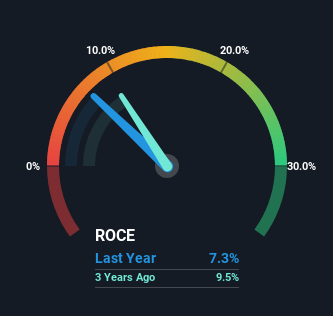- Hong Kong
- /
- Electronic Equipment and Components
- /
- SEHK:3969
Some Investors May Be Worried About China Railway Signal & Communication's (HKG:3969) Returns On Capital

If you're not sure where to start when looking for the next multi-bagger, there are a few key trends you should keep an eye out for. Amongst other things, we'll want to see two things; firstly, a growing return on capital employed (ROCE) and secondly, an expansion in the company's amount of capital employed. Put simply, these types of businesses are compounding machines, meaning they are continually reinvesting their earnings at ever-higher rates of return. However, after briefly looking over the numbers, we don't think China Railway Signal & Communication (HKG:3969) has the makings of a multi-bagger going forward, but let's have a look at why that may be.
Understanding Return On Capital Employed (ROCE)
If you haven't worked with ROCE before, it measures the 'return' (pre-tax profit) a company generates from capital employed in its business. To calculate this metric for China Railway Signal & Communication, this is the formula:
Return on Capital Employed = Earnings Before Interest and Tax (EBIT) ÷ (Total Assets - Current Liabilities)
0.073 = CN¥3.9b ÷ (CN¥118b - CN¥65b) (Based on the trailing twelve months to March 2024).
So, China Railway Signal & Communication has an ROCE of 7.3%. On its own, that's a low figure but it's around the 7.5% average generated by the Electronic industry.
Check out our latest analysis for China Railway Signal & Communication

In the above chart we have measured China Railway Signal & Communication's prior ROCE against its prior performance, but the future is arguably more important. If you'd like to see what analysts are forecasting going forward, you should check out our free analyst report for China Railway Signal & Communication .
So How Is China Railway Signal & Communication's ROCE Trending?
When we looked at the ROCE trend at China Railway Signal & Communication, we didn't gain much confidence. Around five years ago the returns on capital were 13%, but since then they've fallen to 7.3%. Given the business is employing more capital while revenue has slipped, this is a bit concerning. If this were to continue, you might be looking at a company that is trying to reinvest for growth but is actually losing market share since sales haven't increased.
On a side note, China Railway Signal & Communication's current liabilities are still rather high at 55% of total assets. This can bring about some risks because the company is basically operating with a rather large reliance on its suppliers or other sorts of short-term creditors. Ideally we'd like to see this reduce as that would mean fewer obligations bearing risks.
The Key Takeaway
In summary, we're somewhat concerned by China Railway Signal & Communication's diminishing returns on increasing amounts of capital. Long term shareholders who've owned the stock over the last five years have experienced a 18% depreciation in their investment, so it appears the market might not like these trends either. Unless there is a shift to a more positive trajectory in these metrics, we would look elsewhere.
On a separate note, we've found 1 warning sign for China Railway Signal & Communication you'll probably want to know about.
While China Railway Signal & Communication may not currently earn the highest returns, we've compiled a list of companies that currently earn more than 25% return on equity. Check out this free list here.
New: AI Stock Screener & Alerts
Our new AI Stock Screener scans the market every day to uncover opportunities.
• Dividend Powerhouses (3%+ Yield)
• Undervalued Small Caps with Insider Buying
• High growth Tech and AI Companies
Or build your own from over 50 metrics.
Have feedback on this article? Concerned about the content? Get in touch with us directly. Alternatively, email editorial-team (at) simplywallst.com.
This article by Simply Wall St is general in nature. We provide commentary based on historical data and analyst forecasts only using an unbiased methodology and our articles are not intended to be financial advice. It does not constitute a recommendation to buy or sell any stock, and does not take account of your objectives, or your financial situation. We aim to bring you long-term focused analysis driven by fundamental data. Note that our analysis may not factor in the latest price-sensitive company announcements or qualitative material. Simply Wall St has no position in any stocks mentioned.
Have feedback on this article? Concerned about the content? Get in touch with us directly. Alternatively, email editorial-team@simplywallst.com
About SEHK:3969
China Railway Signal & Communication
Provides rail transportation control system solutions in China and internationally.
Undervalued with adequate balance sheet.
Market Insights
Community Narratives



